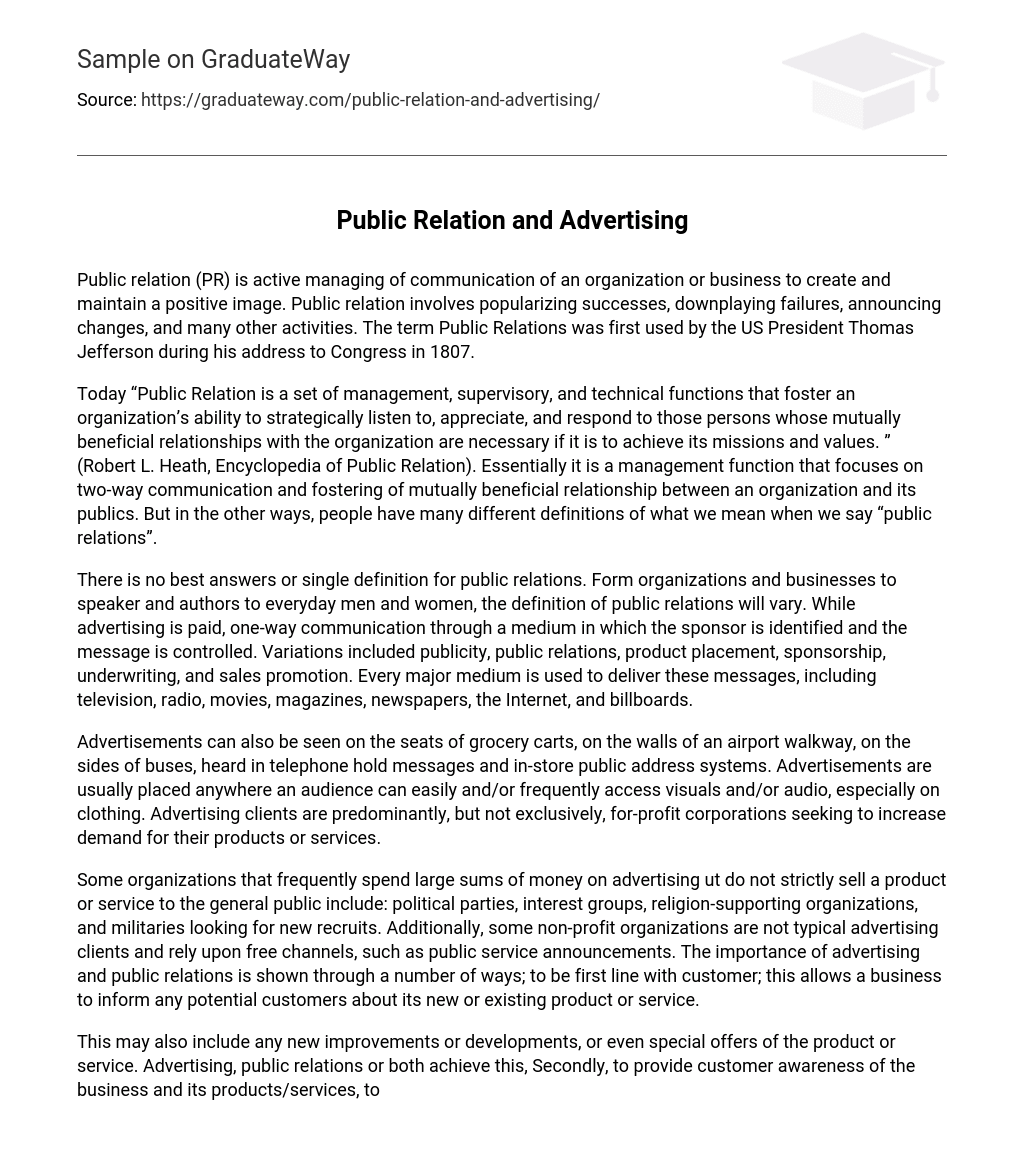Public Relations (PR) refers to the proactive management of an organization or business’s communication in order to create and maintain a positive perception. This includes activities such as highlighting accomplishments, addressing setbacks, announcing changes, and more. The term Public Relations was first coined by US President Thomas Jefferson during his speech to Congress in 1807.
Public relations involves the integration of management, supervisory, and technical responsibilities. It enables an organization to listen to, understand, and meet the needs of individuals with whom it shares mutually advantageous relationships. This is crucial for achieving the organization’s objectives and upholding its core principles (Heath, Robert L., Encyclopedia of Public Relation). Essentially, public relations serves as a managerial role that emphasizes open and reciprocal communication while establishing positive connections between the organization and its stakeholders. Nevertheless, it is important to recognize that there may be varying interpretations of what constitutes “public relations.”
Public relations can have different meanings depending on the entity involved, whether it’s an organization, business, speaker, author, or everyday individual. There isn’t a definitive answer or one-size-fits-all definition for public relations. Conversely, advertising entails paid communication through a designated medium where the sponsor controls the message and is identified. Other related concepts include publicity, product placement, sponsorship, underwriting, and sales promotion. These messages are communicated using various mediums such as television, radio, movies, magazines, newspapers the Internet, and billboards.
Advertisements can be seen on grocery cart seats, airport walkway walls, bus sides, telephone hold messages, and in-store public address systems. They are placed in easily accessible and frequented areas to reach audiences through visual and audio means, including clothing. Advertising clients are mainly but not solely for-profit corporations aiming to boost demand for their offerings.
Some organizations that frequently spend large sums of money on advertising but do not strictly sell a product or service to the general public include: political parties, interest groups, religion-supporting organizations, and militaries looking for new recruits. Additionally, some non-profit organizations are not typical advertising clients and rely upon free channels, such as public service announcements. The importance of advertising and public relations is demonstrated through a variety of ways; to be at the forefront with customers, enabling a business to inform potential customers about its new or existing product or service.
This may also involve promoting any new enhancements or advancements, as well as offering special deals for the product or service. Advertising and public relations, or a combination of both, serve this purpose. Additionally, the aim is to inform customers about the business and its offerings, increase sales by highlighting the appealing features and unique selling points of the product or service, discourage competitors, attract wholesalers, alter perceptions of the business and its offerings, and cultivate goodwill while enhancing the company’s image.
Both advertising and public relations provide valuable benefits. By assessing your budget and needs, you can determine the ideal combination. In the field of education, studying advertising and public relations is highly competitive, making a solid education advantageous. The majority of professionals in this industry are over twenty years old, suggesting that either educational background or work experience is almost essential for entering this field.
Students will not only acquire knowledge about the modern business environment, but also enhance their understanding of interpersonal relationships and improve communication abilities. Public relations focuses on establishing effective communication between companies and clients. Strong communication skills are crucial for businesses to prevent conflicts that may harm relationships and consumer satisfaction. The job market in this industry is highly competitive due to its allure.
Despite this, employment in the field is expected to grow more rapidly than other industries in the next decade. The industry encompasses various occupations such as business, management, financial workers, professionals and related workers, and sales and related workers. The industry is made up of numerous small firms where employees often have multiple roles. On the other hand, larger firms encourage specialization among their staff. Job prospects in this sector are mainly concentrated in major cities with California and New York representing around 20% of companies and over 25% of the workforce.
While working in the industry can be fast-paced and thrilling, it often demands long hours and stress to meet deadlines. If you seek a diverse and dynamic environment, pursuing a graduate degree in advertising and public relations is worth considering. Many mistakenly use “public” and “relations” interchangeably with “advertising,” but these terms have distinct differences.
Public relations and advertising differ significantly in terms of cost. Unlike advertising, PR does not require any financial investment. For instance, placing an advertisement in a local newspaper incurs charges for space and duration. However, if the same newspaper considers your business or product worthy of coverage, you can enjoy free publicity. While advertising has its advantages, it can become negative when advertisers disseminate false or deceptive information to the public.
The negative impact of advertising lies in its exaggeration of products to increase sales. Personally, I consciously avoid allowing advertising to influence my judgments or perspectives on various products. For instance, during a visit to a restaurant, I encountered an appealing image of a food item in the menu picture. However, when my actual dish arrived, it was disappointing as it bore no resemblance to the picture. This incident further solidified my belief that advertising often causes more harm than good. Conversely, I do not perceive public relations as excessively unfavorable. Many individuals mistakenly equate public relations with advertising; however, the crucial distinction is that advertising involves compensation.
Although advertising and public relations are often considered distinct, I contend that public relations primarily centers around communication. This includes both the company’s interaction with customers and its engagement with the community. Public relations focused on marketing strives to achieve similar goals as advertising – increasing brand recognition and promoting a product or message through media presence. Nonetheless, these approaches have notable disparities in terms of expenses, control, and credibility, despite their efficacy in reaching both trade professionals and consumers.





